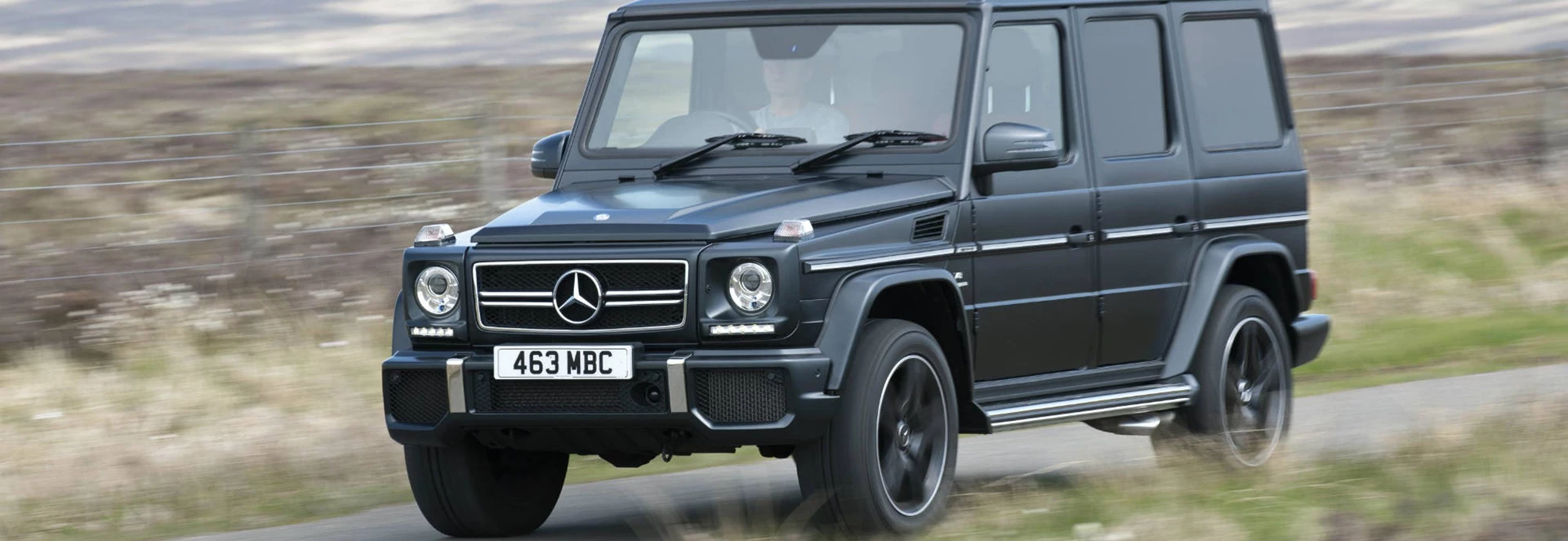The G-Class first went on sale back in 1979, and since then it has changed in some ways very greatly, in others hardly at all. The basic structure has remained the same for over three decades, but there's also a lot of 21st-century technology to enjoy.
Although famously capable in off-road situations, the G-Class is very expensive nowadays, with prices starting at over £86,000. Because of that, it’s more likely to be bought by people who like the idea of driving through cities in a large SUV but don't want to be part of the Range Rover crowd.
Mercedes produces several varieties of the G-Class, but only two are sold in the UK. The more sensible is the G 350 BlueTEC, which has a 208bhp 3.0-litre six-cylinder diesel engine. For extra eccentricity, at a six-figure price, you can have the G 63 AMG with its 5.5-litre petrol V8 producing 537bhp. Both have seven-speed automatic transmission and, of course, four-wheel drive. There's also a 604bhp G 65 AMG, but you can't buy it in this country.
Performance
The G 350 BlueTEC accelerates from 0-62mph in 9.1 seconds, which might not seem very urgent but certainly feels like it from the high driving position. If you insist on more excitement, the G 63 AMG provides it by doing the same run in just 5.4 seconds.
Aerodynamics similar to those of your garden shed limit the top speeds of the two models quite drastically, to 108mph and 130mph respectively.
Both engines are very refined, and the smooth-shifting automatic gearbox, which can also be found in several other Mercedes model ranges, is excellent.
It's unlikely that anyone will use a G-Class for serious off-roading, having paid so much for it, but towing is a different matter. Here the car scores very well, with a maximum towing limit of 3500kg with a braked trailer, regardless of which engine is fitted.
Ride and Handling
Time and experience are required before you can become fully confident of direction changes.
The feel of all the major controls is bang up to date, but the way the chassis reacts to them isn't. Turn the steering wheel to the left, for example, and that's the way the car will go, but to what extent it will do this isn't always clear. Time and experience are required before you can become fully confident of direction changes. Being over six feet tall and weighing slightly more than two and a half tonnes, the G-Class inevitably does a lot of rolling and pitching on country roads, but this is reasonably well controlled.
Interior and Equipment
The G in the name stands for Geländewagen, a German word meaning 'cross-country vehicle'.
Stepping into a late 1970s car and finding that the interior is fitted out like a brand new E-Class is an unusual experience. The level of equipment is very modern, and includes automatic climate control, leather upholstery, DAB digital radio, a reversing camera and a 12-speaker surround sound system. The G 63 AMG has a lot of extra body styling, and there are several option packages for both cars. The AMG model has 480 litres of luggage space with the rear seats up, while the G 350 offers 699. Folding down the rear seats increases the capacity to over 2,000 litres. Rear passenger room is more than adequate, but the front is more cramped, and taller drivers might find themselves wishing that Mercedes had supplied more seat travel.
Cost
CO2 emissions for the two cars are 295g/km for the G 350 and 322g/km for the AMG, making them as expensive as they possibly can be to tax.
The base prices are around £86,500 for the G 350 and nearly £130,000 for the AMG, and there's plenty of opportunity to spend a lot more on optional extras. In no sense can the G-Class be thought of as a bargain. CO2 emissions for the two cars are 295g/km for the G 350 and 322g/km for the AMG, making them as expensive as they possibly can be to tax. Annual Vehicle Excise Duty is £505, and the Benefit In Kind rating is 37 per cent. Combined fuel economy is 25.2mpg for the diesel and 20.5mpg for the V8. Realistically, averaging over 20mpg in either of them would require considerable skill and concentration.
Our Verdict
On one level, it's ridiculous that Mercedes is still selling a car which first went on sale in the same year that Margaret Thatcher became Prime Minister. It's not as if the G-Class is particularly popular, either - annual UK sales are well below 200 units. Be that as it may, there's is still a demand, though admittedly a very small one, and Mercedes has reacted to it by updating the car very effectively. This is undoubtedly an unusual car, but we can just about see the appeal.




